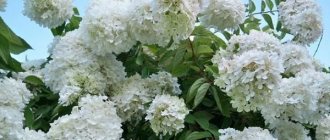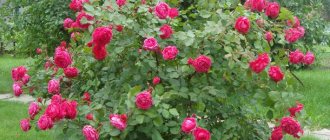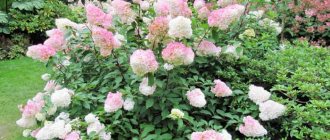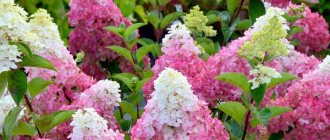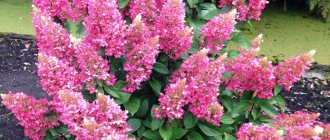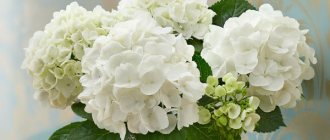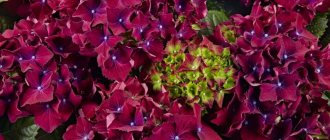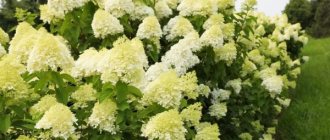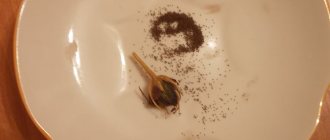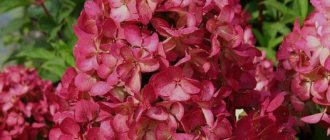Don't know how to decorate your site? Plant the best varieties of paniculata hydrangea. These luxurious plants with a huge number of beautiful varieties will not leave anyone indifferent. Gorgeous paniculate inflorescences up to 25 cm long in the shape of a wide pyramid consist of small and large flowers.
The main feature of flowering hydrangea is its ability to gradually change its color depending on the composition of the soil.
For your attention – our Top 15 beautiful varieties of paniculate hydrangea, which will feel great in the middle zone, for example, in the Moscow region. Photos and descriptions of varieties are accompanied by tips on care and recommendations for growing.
Bobo
The dwarf variety Bobo received the “Best Variety” award at a flower exhibition in Belgium in 2011. During the abundant and long flowering of this hydrangea, the color of its petals changes from white-yellow to soft pink.
Due to its low growth, Bobo hydrangea is suitable for growing in containers that can be placed on a balcony or summer terrace. It is advisable that this be a semi-shaded place, since in the bright sun the hydrangea inflorescences become smaller. It is important that the bush is protected from gusty winds.
| Purpose | Bush height (cm) | Bush width (cm) | Flowering period | Peculiarities |
| 70 | 50 | From July to September | Plant winter-hardy, but the roots young bushes needed for winter mulch | |
Types of hydrangea
The genus Hydrangea includes 52 species. The most popular is large-leaved, with about 600 varieties.
Types of hydrangea for Russian gardens:
- paniculata (Hydrangea paniculata Siebold);
- tree (Hydrangea arborescens);
- large-leaved or garden (Hydrangea macrophylla);
- petiole (Hydrangea petiolaris).
Other common types:
- oakleaf (Hydrangea quercifolia);
- ground cover (Hydrangea heteromalla);
- ashy (Hydrangea cinerea);
- Sargent (Hydrangea sargentiana);
- serrata or serrata (Hydrangea serrata).
Our article is devoted to the paniculate type of hydrangea, its differences, and features. This species belongs to the hydrangea family. Its origins are Japan and China, and its natural range is limited to warmer Asian countries. Paniculate hydrangeas shed their leaves for the winter - they are ovoid, dark green in color, and pointed. In autumn the leaves turn yellow for a short time. This species blooms last of the year, is easy to grow, and does not require shelter regardless of the height of the plant.
The landing site should be as sunny and warm as possible. The soil should be fertile and permeable, slightly acidic - it should also be watered regularly. To fertilize hydrangeas, it is better to use preparations containing calcium and organic fertilizers.
Phantom
The variety is highly valued for its lush flowering and the unique honey aroma that the beautiful flowers emit. In summer, the inflorescences are light cream, and by autumn they become pinkish, while their tops turn yellow. The petals of this plant are slightly different from other hydrangeas: they are slightly elongated and are not located so closely to each other.
| Purpose | Bush height (cm) | Bush width (cm) | Flowering period | Peculiarities |
| 200 | 200 | From July to September | In the middle lane young plants may freeze so their cover layer of mulch | |
Description of popular varieties
Paniculate hydrangea is one of the most valuable and versatile ornamental shrubs. There are many varieties that can be distinguished. Let's take a closer look at the varieties of hydrangeas often grown in gardens.
Compared to other species that are found in Russian gardens, paniculate hydrangeas are the most resistant to low temperatures; they are winter-hardy and tolerate frosts down to -30 °C.
It should be remembered that potted hydrangeas need to be protected from frost in winter (by wrapping the pots with polystyrene). The plants are frost-resistant, but their roots may freeze in very cold winters.
The shrub is also characterized by the following positive qualities:
- high resistance to drought;
- resistance to exposure to full sun;
- low soil requirements;
- long, abundant flowering - the longest flowering period of the ornamental species cultivated in our country.
Grandiflora
By far the most popular variety is Grandiflora. This winter-hardy and frost-resistant shrub is grown in Siberia, the Urals, the Moscow region and many other regions.
The white inflorescences consist mainly of fertile flowers and are cone-shaped up to 30 centimeters long and 10 cm wide at the base. Blooms from August to late autumn. Over time, the lush flowers change color to slightly pink. The highly branched white hydrangea grandiflora grows up to 200cm, making it one of the most impressive varieties of the species.
Limelight
The plant has creamy white, conical flowers. The shrub reaches 200 cm in height and 140 cm in width.
Diamant Rouge
The variety blooms relatively early (in May). At first the flowers are creamy white, but later they turn a deep red color. This shrub will decorate every garden!
Vanilla Fraise
Vanilla Fries are hardy hydrangeas with beautiful pink flowers that turn deep purple in October. The bush grows up to 200 cm in height. It has an erect crown, moderately branched.
Polar Bear
Huge inflorescences (up to 40 cm in length) are a trademark of the Polar Bear hydrangea. Grows up to 150 cm. The varietal variety is recommended for moderately fertile, moist and permeable soil. The flowers start out lemon yellow, then quickly fade to pale white to reach light pink in late summer. This is a fun garden decoration all summer long. The Polar Bear variety is characterized by increased frost resistance and can withstand up to -40 degrees.
Tender Rose
Rare collectible variety. A shrub with a regular, compact shape, with straight, obliquely upward directed shoots. Reaches 2 meters in height and similar width. The leaves are dark green. In summer, decorative, cone-shaped inflorescences 20 centimeters long appear at the ends of the shoots, consisting of several decorative, four-petalled sterile flowers and numerous inconspicuous fertile flowers. The flowers are white, gradually changing color to pink. The flowering period lasts from July to September.
The bush grows well on humus, slightly acidic soils, in sunny or semi-shaded places. A moderately moist substrate is required, especially during flowering. The plant is completely resistant to frost and does not require shelter. Moderate pruning of last year's shoots to 1/4 length in early spring is recommended.
Silver Dollar
The winter-hardy hydrangea variety Silver Dollar grows up to 200 cm, 1.3 m wide. The flowers develop quite late (in August) and bloom until October. The shrub creates an attractive accent in the garden even in winter. Silver Dollar flowers are initially greenish and later turn white.
The stems are straight, directed upwards. The dense inflorescences consist exclusively of four-petaled, sterile flowers. The inflorescences are quite large, up to 30 cm long. Unlike other varieties, the flowers do not turn pink during flowering for a long time, but remain white and cream.
The shrub grows best on humus soils with a slightly acidic reaction. Requires moderately moist soil, especially during flowering. It grows well in semi-shaded areas, although it can also be planted in full sun if the substrate has enough moisture. The variety is completely frost-resistant and does not require shelter. Moderate rejuvenation is recommended every 2-3 years to ensure good buds.
Phantom
Phantom's inflorescences are huge - up to 30 cm long and smoothly change color from white to pink-red. This low-growing shrub with a simple shape looks good both separately and in a group composition. The variety is not very widespread, but is considered by hydrangea lovers as one of the best representatives of the paniculate species. Grows up to 3 meters. The shrub is winter-hardy, frost-resistant, and is grown even in Siberia.
Anabelle
The bush grows up to 150 cm, flowers appear from June to August. This plant has beautiful creamy white flowers, and there is also a pink hydrangea of this variety.
Kyushu or Kyushu
White hydrangea attracts butterflies to the garden with its pleasant aroma. The bush reaches a height of 250 cm and a width of 300 cm, clearly dominating other varieties of paniculate hydrangea. People often say that these are the most beautiful hydrangeas in the garden. The shrub is winter-hardy and frost-resistant, grown even in Siberia.
Magical Fire
The compact variety “Magic Fire” is designed for seekers of pink hydrangea; it grows up to 2 m. The flowers are initially white, quickly changing color during the season: at the first stage they become pink, then red.
Pinky Winky
A shrub with straight shoots and very decorative inflorescences. It grows slowly and has a compact shape compared to other paniculate varieties. It can reach a height of 1.6 m, a width of 1.4 m. Double inflorescences, consisting mainly of sterile flowers, are white at the beginning of flowering, quickly changing color to pink or red. Blooms from late July to October.
Prefers humus soils. Requires a moderately moist position, especially during flowering, in a sunny or semi-shady position. It is advisable to do rejuvenation pruning in early spring every 2-3 years to obtain impressive inflorescences. The shrub is completely frost-resistant.
Great Star
The Big Star variety produces exceptionally original inflorescences that resemble miniature windmills. The inflorescences are more spherical and flattened than those of other varieties. The flowers are pure white for a long time, later turning pink.
Levana
A vigorous growing shrub with snow-white lacy inflorescences beautifully presented against a background of light green leaves. Height up to 2 meters.
Brussels Lace
An upright shrub with a compact crown grows up to 1.6 m in height. White, cone-shaped inflorescences resemble lace, the variety received the colorful name “Brussels lace”. Flowering is very abundant.
Magical Sweet Summer
It grows well even in small containers and produces very tough shoots. Numerous large white inflorescences turn pink in autumn.
Polistar
One of the newest (2016) low varieties (up to 0.6 m in height). Its main advantages:
- compact shape;
- very abundant flowering;
- tolerates shade well.
From mid-June to late autumn, Polystar will be an excellent decoration for any terrace. Flowers are formed on annual shoots. The leaves are small, dark green, turning dark burgundy in autumn. The shrub needs medium-fertile, moderately moist soil; it prefers sunny positions and grows well in partial shade.
Does not get sick, is not attacked by pests. Its small size makes it ideal for planting in containers. Before the onset of winter, the root system of a hydrangea planted in a container must be protected from freezing.
Magical Candle
A proven, reliable shrub that forms large white inflorescences with a slight green tint at the ends of rigid shoots. Grows up to 1.2-1.5 m. Suitable for creating hedges.
Everest
The Everest variety is characterized by elegant dark green leaves; large white inflorescences turn pink over time.
Unique
In the “Unique” variety, large inflorescences reach up to 40 cm in length and gradually change color from white to purple. The shrub reaches 2-3 m in height.
Lime light - hydrangea on a trunk
This variety is formed on a standard. The “tree” makes a spectacular visual impact when in bloom! A very interesting hydrangea variety with an unusual flowering tree shape that changes throughout the season. The inflorescences range in color from green to cream and white. The plant has low soil requirements and unusual decorative qualities.
It is recommended to use the variety in the following variants:
- in small gardens;
- planted in open places;
- looks very impressive in rows;
- Great for planting in containers on balconies and terraces.
Low pruning leads to the growth of strong young shoots and the formation of beautiful, wide-cone-shaped inflorescences up to 30 cm long, lemon-colored, yellow, and white.
This is one of the most frost-resistant varieties of hydrangea, which, regardless of unfavorable wintering climatic conditions, blooms tirelessly and profusely every year. Prefers sunny or semi-shaded positions.
The inflorescences can be removed and used for winter bouquets.
Color variations
Spiraea - species and varieties with white and pink flowers
Red or crimson hydrangea, for example, the Prima variety, will become a bright decoration of any garden plot. The Goliath variety is distinguished by deep pink inflorescences with a diameter of about 25 cm.
White flowers are the most popular; hybrid varieties are distinguished by their ease of care, immunity to diseases and frost resistance.
Variety Ramars is a decorative purple hydrangea. Alba is a beauty with soft pink petals.
Green hydrangea is not particularly decorative, but thanks to the unusual color of the petals it looks very elegant.
Yellow hydrangea can be grown in flower beds or used as a component of landscape compositions; this plant also looks beautiful when planted alone thanks to its elegant lush inflorescences, reminiscent of the sun descending from heaven to earth.
Burgundy hydrangea is a real aristocrat of the flower world. The easiest way to propagate this noble flower is by cuttings. Can be used as a cut flower to make bouquets.
Amazing hydrangea flowers are good for making original bouquets
Limelight - 2 m
Hydrangea Limelight is the result of the work of breeders who sought to create a variety capable of independently holding huge corollas of flowers without breaking under their weight.
This variety is deciduous, which is why it is so loved by summer residents living in regions with short summers and snowy winters. Limelight inflorescences are similar in description to lilac inflorescences. In botany, this brush structure is usually called a panicle. Under favorable conditions, not a single plant is left without a panicle in the summer, and closer to autumn the flowers transform into pink tones.
Designers fell in love with this particular variety of hydrangea because it needs to be pruned every year, and thanks to this, the flower can be pruned, giving it any geometric shape.
Landing Features
Hydrangeas are spreading flowers, reaching a diameter of up to 3 m. When planting, the distance between individual specimens is determined by morphological properties.
The tree-like subspecies have the widest crown - 10-year-old representatives grow to the size of a small tree.
Large-leaf forms are half as tall, but approach one and a half meters in width. There are climbing subspecies that reach the 3rd floor of the house. Accordingly, the minimum distance, depending on the variety, ranges from 90 cm to 3 m.
Deadlines
As a rule, plants are planted in two seasons - autumn or spring. In summer it is too hot for this, especially since drought can set in, and Hydrangeas love moist air.
Hydrangea red miss
In winter, there is too little sunlight in the premises for harmonious development. And again - dry air from the batteries.
Preparatory work
Hydrangea grows everywhere. Indeed, it prefers sunny places with partial shade, but it also grows well in the shade. Except that the colors will be less vibrant.
Although Hydrangeas respect water and love slightly moist soils, during the rainy season the roots and greenery can be damaged by fungal infections. If the groundwater is shallow somewhere, it is advisable to equip a drainage system at the proposed planting site.
When choosing a plant for the garden, first of all, you need to pay attention to its color and elasticity. Pale leaves, sluggish young shoots, the presence of strange spots and fluffy coating should alert you. Most likely, this specimen is sick. What is dangerous is not even the fact that the seedling may die. It can infect neighboring flowers with fungal or bacterial infections, and the entire area with rust.
Special preparation before landing is not required. According to the botanical description, hydrangeas are strong, life-loving plants that easily take root and take root in a new place. However, it is not superfluous to treat the roots and green mass with a fungicide for prevention, as well as strengthen the immune system with immune preparations - inducers.
“Symbiont-universal”, “Immunocytophyte”, “Novosil” have proven themselves well. A new generation has appeared based on chitosans (chitin derivatives), for example, “Narcissus”, “Slox-eco Artemia”, “Ecogel”. They are practically non-toxic and, in combination with inducers, make it possible to avoid the development of diseases. Humates "Zircon", "Silk" and "Epin" stimulate growth.
Landing technology
- Dig a hole slightly deeper than the root ball and 2-3 times wider.
- Place the seedling in the hole and fill it halfway with soil. Water. After the water has been absorbed, fill the rest of the hole with soil.
- Water thoroughly again so that the voids between the roots are filled with soil.
Polar Bir - 1.8 m
This hydrangea variety has the highest winter hardiness. It feels good even at temperatures of -40º, which, of course, is its advantage. Thanks to these qualities, Polar Beer is grown with pleasure by gardeners from all over the world.
During flowering, the plant changes color - from pistachio to pink, which overall makes the garden design elegant. Quite large flowers grow up to 1.8 meters, and their amazing aroma can turn the head of anyone who happens to be nearby.
Polar Bir needs moist soil, especially if it is in full sun. To make the flower comfortable, it is recommended to plant it in a place open to light.
Garden novelties and rarities
Hydrangea paniculata variety Pastel Green
SUPER compact and still VERY rare (2016) variety.
Flowers can be light green, white, pink and raspberry pink.
Hydrangea paniculata variety Pastel Green
Hydrangea paniculata variety Magical Vesuvio, Magical Vesuvio
A new and still rare variety with a beautiful bush shape (up to 1.5 m in height). Large inflorescences are white when in bloom, then turn pink and become burgundy by autumn.
Hydrangea paniculata variety Magical Vesuvio (photo Agroholding SEARCH)
Hydrangea paniculata variety White Light, Whitelight
Awarded a gold medal at the Plantarium 2019 exhibition (Holland).
A compact, low (up to 1 m) bush grows easily and branches well. The dark green leaves contrast beautifully with the white flowers. The flowers are initially lemon-colored, then turn creamy and eventually white. In autumn they turn pink.
Ideal for use on terraces, patios, balconies.
Hydrangea paniculata variety White Light, Whitelight (photo Agroholding SEARCH)
Hydrangea paniculata variety Samme Snow, Summer Snow
NEW 2019
A dense, low bush with strong straight shoots, has a neat appearance and does not fall apart. The inflorescences of sterile flowers are very large. The flowers are white and do not change color throughout the season.
Hydrangea paniculata variety Samme Snow, Summer Snow (photo Agroholding SEARCH)
Hydrangea paniculata variety Samara Lydia>>>
Nico Blue - 2 m
The variety was bred specifically for cultivation in temperatures of minus 22 degrees. The attractive plant is often used to decorate gardens, urban areas, etc. Niko Blue is widespread in South and East Asia - the shrub grows up to 2 m in height, completely covered with spherical inflorescences. They are large in size, fragrant and fluffy.
The color of a plant comes from factors such as lighting, soil composition, watering. If the flower is in an open area, then its inflorescences will be bright, and if the indicator is of medium acidity, then Nico Blue will turn dark blue. This variety of hydrangea blooms for a long time and goes well with evergreens.
